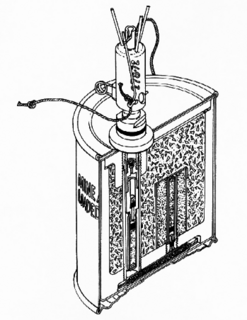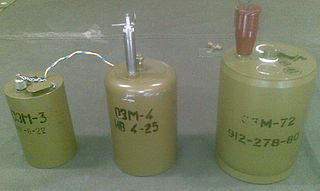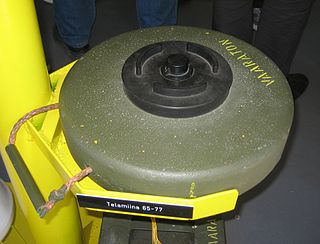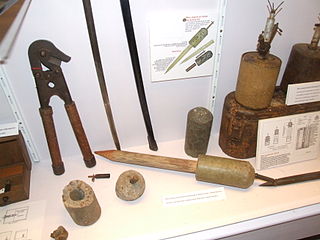The GATOR mine system is a United States military system of air-dropped anti-tank and anti-personnel mines developed in the 1980s to be compatible with existing cluster dispensers. It is used with two dispenser systems—the Navy 230 kg (500 lb) CBU-78/B and the Air Force 450 kg (1,000 lb) CBU-89/B. Additionally the mines are used with the land- and helicopter-based Volcano mine system.

The International Campaign to Ban Landmines (ICBL) is a coalition of non-governmental organizations whose stated objective is a world free of anti-personnel mines and cluster munitions, where mine and cluster munitions survivors see their rights respected and can lead fulfilling lives.
The military of the United States has used many different types of hand grenades since its foundation. Presented on this page is a basic overview.

The M16 mine is a United States-made bounding anti-personnel mine. It was based on captured plans of the World War II era German S-mine and has similar performance. The mine consists of a cast iron body in a thin steel sleeve. A central fuze well on the top of the mine is normally fitted with a pronged M605 pressure/tension (tripwire) fuze. Sufficient pressure on the prongs or tension on an attached tripwire causes the release of a striker. The freed striker is forced into a percussion cap which ignites a short pyrotechnic delay. The purpose of this delay is to allow the victim to move off the top of the mine, to prevent its upward movement from being blocked. Once the delay has burned through, a 4.5-gram black powder charge is ignited, which launches the inner iron body of the mine up into the air. The charge also ignites a second pair of pyrotechnic delays.

The PMD-6, PMD-7 and PMD-57 series mines are Soviet Union blast-type anti-personnel mines that consist of a wooden box with a hinged lid with a slot cut into it. The slot presses down against a retaining pin, which holds back the striker. When sufficient pressure is applied to the lid of the box the retaining pin moves, allowing the striker to hit the detonator. The mines typically have an operating pressure of 1 to 10 kg. All the mines in the series use Metal Oxide Varistor series fuzes.

Anti-personnel mines are a form of mine designed for use against humans, as opposed to anti-tank mines, which are designed for use against vehicles. Anti-personnel mines may be classified into blast mines or fragmentation mines; the latter may or may not be a bounding mine.
The POMZ, POMZ-2 and POMZ-2M are three types of Soviet-made stake mounted anti-personnel fragmentation mine. The POMZ mine was used during the Second World War. It was superseded by the POMZ-2, and later by the improved POMZ-2M. These mines have been used in numerous conflicts, including the Vietnam War and the Korean War.

The PROM-1 is a Yugoslavian manufactured bounding anti-personnel mine. It consists of a cylindrical body with a pronged fuze inserted into the top of the mine. It is broadly similar in operation to the German S-mine.

The OZM-3, OZM-4 and OZM-72 are Soviet manufactured bounding type anti-personnel mines. (fragmentation-barrier mine, in the Russian and other post-Soviet armies as informally called "frog mine" or "witch" )

The TMA-3 is a circular Yugoslavian minimum metal anti-tank blast mine. It is very similar in appearance to the TMA-4. The mine consists of a cast circular block of explosive cased in resin reinforced fabric. The top of the mine has three fuze wells which each take a UTMA-3 fuze, and a fourth secondary fuze well is provided in the base of the mine to fit an anti-handling device. The fuze wells may also accept a number of other fuzes, including the UPROM-1, and other fuzes, potentially allowing tripwire activation. The small pressure plate area of the UTMA-3 fuzes gives the mine good resistance to minefield clearance techniques which used blast overpressure techniques i.e. explosive charges.

The VS-JAP is an Italian bounding anti-personnel mine. It is the latest of the Valmara family of bounding mines that includes the Valmara 59 and Valmara 69. The mine has a waterproof plastic faceted cylindrical body with a three-pronged cap, with a central fixing point for a tripwire. The fuze is triggered via downward or sideways pressure.

The TM 65 is a circular Finnish minimum metal anti-tank blast mine. It is broadly based on the Russian TM-62 mine. The mines body is made from a thin shell of fibreglass over a cast block of explosive, with a central fuze well that holds the pressure fuze. The original TM 65 used a US-65 fuze as used in the SM-65 anti-personnel mine, the later TM 65 77 uses a pressure fuze similar to the Russian MV-5 fuze called Painesytytin 77.
The MBV-78-A2 is a small cylindrical Vietnamese anti-personnel fragmentation stake mine. It is unrelated to the MBV-78-A1. The mine has a large plastic head which contains the main charge wrapped around the detonator. A fragmentation layer of steel pieces set into wax surrounds the main charge. The plastic head has two mounting lugs for stake mounting the mine. A Vietnamese copy of the Russian MUV fuze is typically used with the mine, although other fuzes could be used.

The Stockmine, also Betonmine, was a German anti-personnel stake mine used during the Second World War. It consisted of a cylindrical concrete main body on top of a short wooden stake. The concrete head contained a small TNT bursting charge, and was embedded with a number of metal fragments. A fuze is fitted to a central fuze well on the top of the mine. It could be used with a range of fuzes including the ZZ 35, ZZ 42 and ZU ZZ 35 that would trigger on either a tripwire pull or release.

The Mle 1939 was a French anti-personnel bounding mine used at the start of the Second World War, it was developed largely in response to the German S-mine bounding mine. It saw very little service before the fall of France. The plans escaped to the US via Major Pierre Delalande, a member of the French Corps of Engineers, and were used as the basis for the American M2 bounding mine which saw wider service during the war but was considered largely ineffective. The M2 mine was replaced almost immediately afterwards with the M16 bounding mine, an almost exact copy of the German S-mine. The French also later produced a copy of the S-mine, the Mle 1951 mine.
The VAR/40, VAR/100 and VAR/100/SP are Italian anti-personnel blast landmines produced by the Tecnovar italiana S.p.A. company.
The BM/85 is an Italian blast resistant bounding anti-personnel mine that was produced by Tecnovar italiana SpA. The mine is cylindrical with a three pronged tilt/pressure fuze on the top with a central post for attaching a tripwire. A plastic safety clip prevents the fuze from tilting when in transit. Once the pressure clip is removed the mine is armed. Once the fuze is pulled sideways by a trip wire or by downward pressure, the mine is triggered. A small charge launches the mine to a height of about 0.45 meters where it explodes scattering 1,000 fragments to a lethal radius of about 25 meters.
The M432 is a Portuguese bounding anti-personnel mine, which traces the roots of its design to the Second World War German S-mine, although it is probably more directly related to the Belgian NR 442 mine and United States M16 mine. As of 2004, all operational stocks of the mine have been destroyed, although some may have been retained for training purposes.
In military munitions, a fuze is the part of the device that initiates function. In some applications, such as torpedoes, a fuze may be identified by function as the exploder. The relative complexity of even the earliest fuze designs can be seen in cutaway diagrams.

Poudreries Réunies de Belgique SA was one of Belgium's oldest and largest manufacturers of munitions, once the second-largest Belgium armaments manufacturer. The company indirectly started in 1778 in Wetteren as a gunpowder factory. By its 200th anniversary in 1979 it had 73 factories throughout the world, with the headquarters in Brussels.












